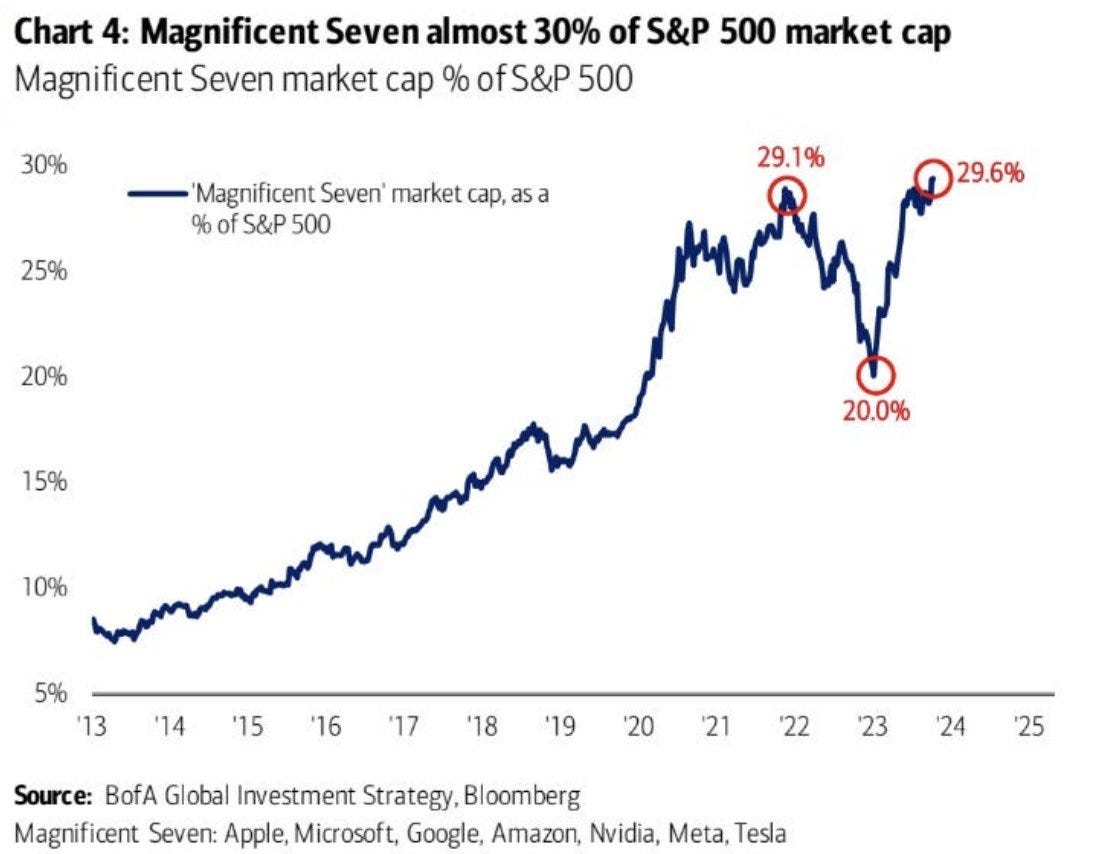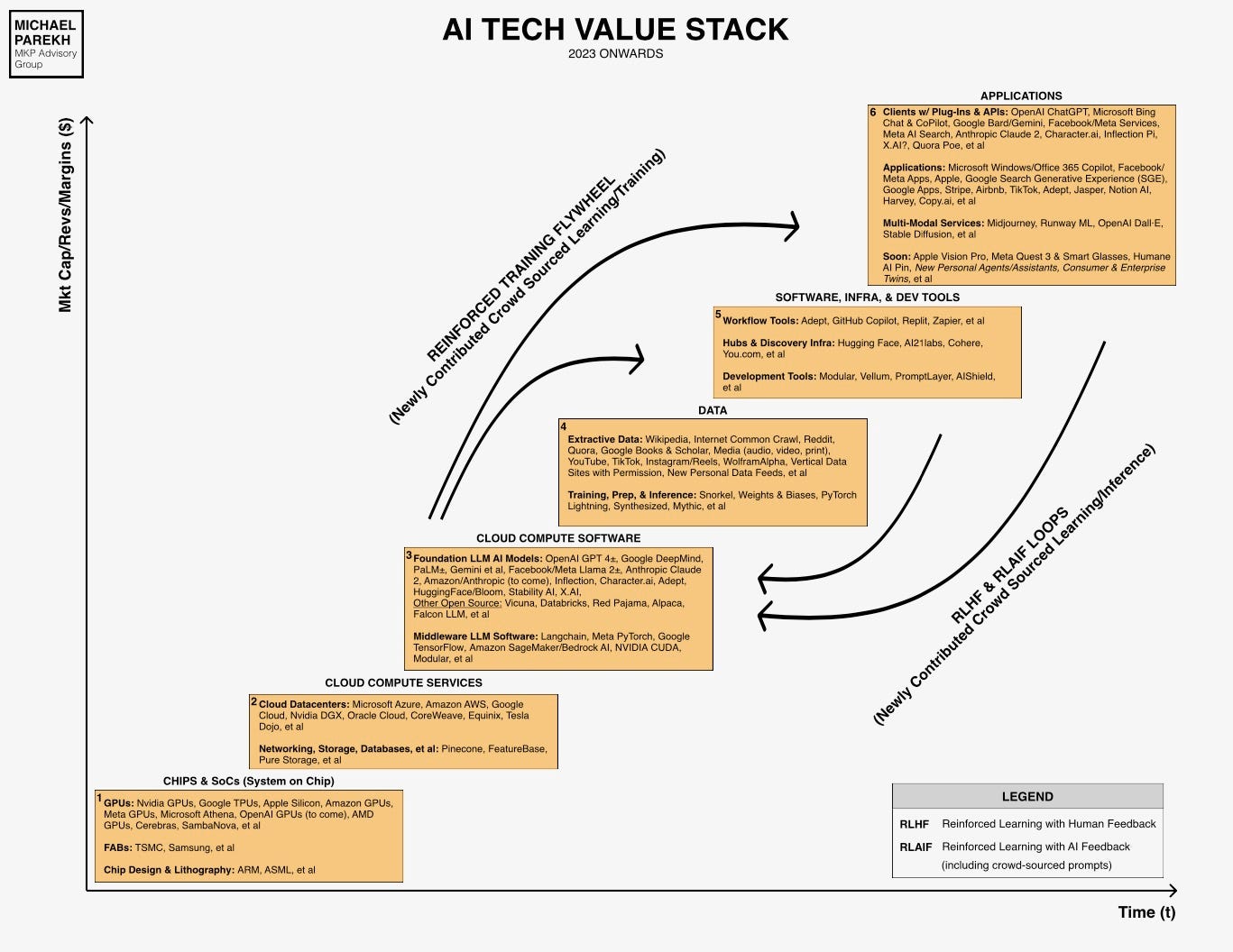AI: Nvidia & Jensen Huang on AI Stage
...thirty years to out-grow its Graphics roots
Apple didn’t stop being ‘Apple Computer’ until 2007, over 31 years after its founding on April 1, 1976. That year, 2007, was of course when Steve Jobs unveiled the iPhone to the world.
This year, 2023, a year after OpenAI’s ‘ChatGPT moment’, becomes the year that Nvidia is no longer a Graphics card company, also three decades after its founding on April 5, 1993 by its current CEO Jensen Huang, and his co-founders Chris Malachowky, and Curtis Priem. Their humble start at a Denny’s in Santa Clara, California, was with a vision to bring 3D graphics to the gaming and multimedia markets. And they almost catastrophically failed a number of times before making it to the Big Time.
Something about that month April for founding iconic technology companies, with Microsoft being formed April 4, 1975, making three of the ‘Magnificent Seven’ tech companies April-born besides Apple and Nvidia. The other four are course are Google, Meta (aka Facebook), Amazon, and Tesla, together almost 30% of the US S&P 500.
The reason for this observation today is a timely profile piece on Nvidia and its CEO-Founder Jensen Huang, providing useful context on its not so overnight journey to becoming the foundation of the AI Tech Wave, as it stands in these early days in 2023.
As the piece aptly titled “How Jensen Huang’s Nvidia is Powerig the AI Revolution” highlights its humble beginnings:
“The revelation that OpenAI’s ChatGPT, the astonishing artificial-intelligence chatbot, had been trained on an Nvidia supercomputer spurred one of the largest single-day gains in stock-market history. When the Nasdaq opened on May 25, 2023, Nvidia’s value increased by about two hundred billion dollars. A few months earlier, Jensen Huang, Nvidia’s C.E.O., had informed investors that Nvidia had sold similar supercomputers to fifty of America’s hundred largest companies.”
“By the close of trading, Nvidia was the sixth most valuable corporation on earth, worth more than Walmart and ExxonMobil combined. Huang’s business position can be compared to that of Samuel Brannan, the celebrated vender of prospecting supplies in San Francisco in the late eighteen-forties. “There’s a war going on out there in A.I., and Nvidia is the only arms dealer,” one Wall Street analyst said.”
“Huang is a patient monopolist. He drafted the paperwork for Nvidia with two other people at a Denny’s restaurant in San Jose, California, in 1993, and has run it ever since. At sixty, he is sarcastic and self-deprecating, with a Teddy-bear face and wispy gray hair. Nvidia’s main product is its graphics-processing unit, a circuit board with a powerful microchip at its core. In the beginning, Nvidia sold these G.P.U.s to video gamers, but in 2006 Huang began marketing them to the supercomputing community as well.”
“Then, in 2013, on the basis of promising research from the academic computer-science community, Huang bet Nvidia’s future on artificial intelligence. A.I. had disappointed investors for decades, and Bryan Catanzaro, Nvidia’s lead deep-learning researcher at the time, had doubts. “I didn’t want him to fall into the same trap that the A.I. industry has had in the past,” Catanzaro told me. “But, ten years plus down the road, he was right.”
“In the near future, A.I. is projected to generate movies on demand, provide tutelage to children, and teach cars to drive themselves. All of these advances will occur on Nvidia G.P.U.s, and Huang’s stake in the company is now worth more than forty billion dollars.”
I have long maintained in these pages that without Nvidia’s steadfast early innovations in AI computing, not just the GPUs (graphical processing units), but other critical software and hardware components like CUDA, DGX, and several other key pieces, ‘AI’ would just be two non-adjacent letters in the English alphabet. Without the AI hardware from Nvidia, none of the exponential growth in computing calculations underlying the training and inference ‘reinforcement learning’ loops in AI would be possible.
Without the hardware and software infrastructure, there’d be no existential debates around the perils and promise of AI. No drama around corporate governance at OpenAI. No computers that are finally learning to ‘hallucinate’ less, not just provide mathematically accurate answers to the umpteeth decimal, as they’d done for decades prior.
The whole piece above is worth reading, if only to underline what it takes to make technology innovations possible. All the wrong turns taken before the right one seems ‘so obvious’ in hindsight.
The other reason Jensen’s story speaks to me so deeply and personally, is his is a tale too of an immigrant kid from somewhere else that didn’t fit for a long time. As the New Yorker explains:
“Huang was born in Taiwan in 1963, but when he was nine he and his older brother were sent as unaccompanied minors to the U.S. They landed in Tacoma, Washington, to live with an uncle, before being sent to the Oneida Baptist Institute, in Kentucky, which Huang’s uncle believed was a prestigious boarding school. In fact, it was a religious reform academy.”
“Huang was placed with a seventeen-year-old roommate. On their first night together, the older boy lifted his shirt to show Huang the numerous places where he’d been stabbed in fights. “Every student smoked, and I think I was the only boy at the school without a pocketknife,” Huang told me. His roommate was illiterate; in exchange for teaching him to read, Huang said, “he taught me how to bench-press. I ended up doing a hundred pushups every night before bed.”
I remember being a ‘wet behind the ears’ seventeen year old from India and Kuwait, arriving in Auburn, Alabama and being introduced to realities in rural America. That’s when I met my dorm room-mate cleaning a shotgun and drinking out of a bottle of Jack Daniels. Remember him stumbling at my first name ‘Mukesh’, with a ‘Mu…what??’
And me replying ‘Call me Mike’, thus becoming ‘Michael Parekh’ for over forty-five years now. We went onto become fast friends, and I’m still a good shot thanks to him teaching me how to shoot on a tobacco farm. I helped him migrate from selling bibles to encyclopedias door to door.
I’m no Jensen Huang, but I empathize with his journey to America, and figuring out how to belong in this amazing place and contribute however possible. America assimilating immigrants to do their best is the country’s super-power, despite the vicissitudes of its politics.
Jensen Huang is a product of immigrants in America, much like Steve Jobs’ father came from Syria. Or how two of the ‘Ya’s, Ilya at OpenAI and Satya at Microsoft also came here as immigrants. It’s one of the reasons I’m proud that an element of President Biden’s 800 pages plus AI Executive Orders includes provisions for human capital for US AI development.
America has a lot to contribute to the AI Tech Wave going forward, both in innovation and investment leadership.
It’s useful to remember how so many people have come together here from places far and wide to make the promise of the technologies possible. Many more in the chart above.
Jensen Huang deserves to take a bow thirty years after his company growing into an AI company from humble beginnings in graphics. Stay tuned.
(NOTE: The discussions here are for information purposes only, and not meant as investment advice at any time. Thanks for joining us here)







Loved this read!